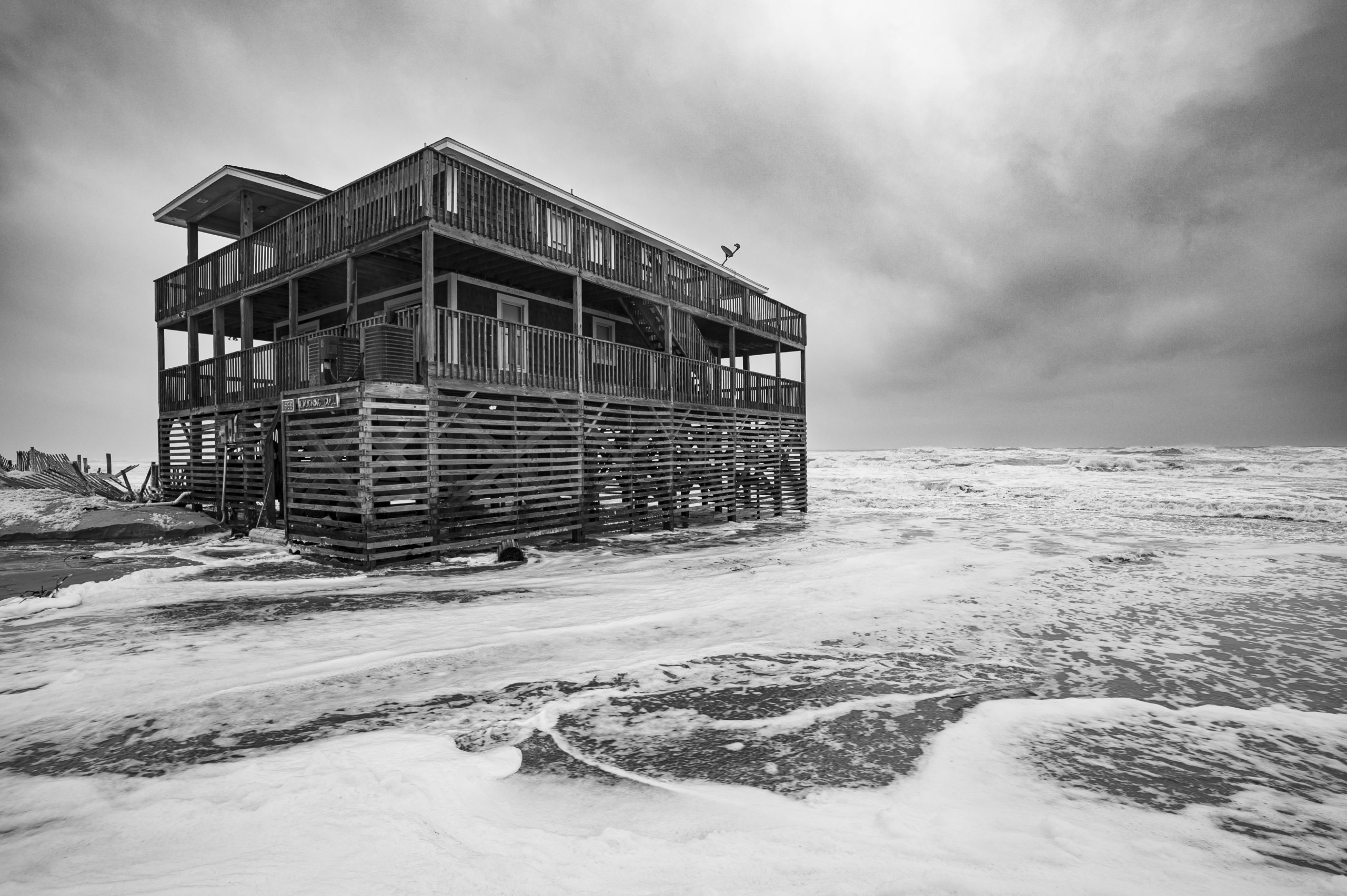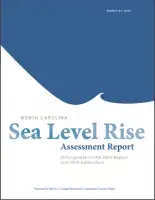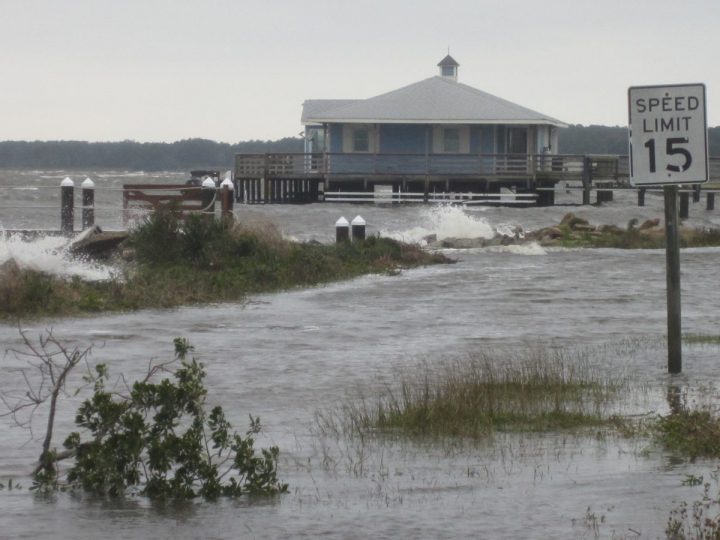
A state assessment of sea level rise compiled a decade ago met fierce political pushback, but in the years since, North Carolina has boosted its efforts to study and prepare for climate change, and some say work to address issues now commonly associated with rising seas had begun years earlier.
In 2009, the state Coastal Resources Commission directed its panel of scientists to put together state-level data and projections regarding sea level rise, rather than relying on international and national reports.
The next year in March, the CRC Science Panel, with contributions from other state experts, released its North Carolina Sea Level Rise Assessment Report. It included high, medium and status quo projections through 2100, along with a recommended planning benchmark of 1 meter, or around 39 inches, of sea level rise by 2100.

Spencer Rogers, a member of the science panel, said that the science had “a rough start” 10 years ago, “when the Science Panel on Coastal Hazards Sea Level Rise report for the Coastal Resources Commission was prohibited by law from application by the General Assembly.” Rogers is on the faculty of University of North Carolina Wilmington’s Center for Marine Science and is the coastal construction and erosion specialist with North Carolina Sea Grant.
Jessica Whitehead, who was named last year as the state’s first chief resilience officer said in a recent interview that the science itself was sound, and the expectation was that sound policy would follow.
Ten years ago, Whitehead, who heads the North Carolina Office of Recovery and Resiliency, or NCORR, was working a split position with South Carolina Sea Grant Consortium and North Carolina Sea Grant, based out of Charleston and serving both states. In her role at the time, she attended and provided input at workshops that led into both the first state sea level rise report and another guide intended for public and private planners, the 2012 Climate Ready North Carolina: Building a Resilient Future report.
“The approaches we took 10 years ago to climate planning were state of the art for the field at the time,” Whitehead explained. “2010 was still the ‘information deficit’ model of climate planning: everyone thought that if you did a climate assessment and provided information on what the ranges of average temperature and rainfall would be under climate change, that would be all decision makers needed to come up with and implement policy to reduce those risks.”

But in response to the release of the 2010 report, two bills were introduced in the North Carolina General Assembly, one that didn’t pass followed by a successful measure that put constraints on what the state could do regarding sea level rise.
The 2012 law forbid adoption of any rule or policy that defined a rate of sea level rise for regulatory purposes. And while it made the CRC the sole state agency authorized to define rates of sea level rise, it was directed to refrain from setting rates for regulatory purposes prior to July 1, 2016.
Rogers said that the report was intended as a planning rather than regulatory document, so restricting any implementation “had little impact.”
Rogers said that to the General Assembly’s credit, the 2012 legislation also required five-year updates to the sea level analysis, “making North Carolina one of the few, if not the only state, with legislation requiring peer-reviewed, sea level rise reporting.”
The final draft of the report was complete March 31, 2015, and the report was finalized March 1, 2016.
Rogers also noted that the 2015 updated report was delivered without apparent controversy in the General Assembly or the Coastal Resources Commission.

East Carolina University geologist Stan Riggs, who was a founding member of the science panel, resigned from the post in July 2016, for reasons including lingering frustration with the General Assembly’s response to the 2010 report. He’s more encouraged with the way the latest required five-year update to the report is being handled.
“The CRC has backed off to allow the science panel to do their (2020) report based on the science, not dictated by the way the 2015 report was. We were told exactly what we could do, what we couldn’t do, who we could talk to, who would review. And that was outrageous. That was just unacceptable,” Riggs told Coastal Review Online in mid-May.
Tancred Miller is the coastal and ocean policy manager with the Department of Environmental Quality’s Division of Coastal Management. Miller said that the updated report in 2015 included regional rates of sea level rise for different parts of the coast, based upon tide gauge data and Intergovernmental Panel on Climate Change, or IPCC, scenarios. Although the prohibition against adopting sea level rise rates for regulatory purposes has since expired, the CRC has not yet considered adopting any sea level rise policies or regulations.
In 2019, the CRC directed its science panel to begin work on the 2020 update, and while the science panel has started, its ability to meet and work has been hampered by the COVID-19 pandemic.
“The panel has been requested to update the report for 2020 and work is underway,” Rogers said. Although COVID-19-related restrictions will delay its completion, “the primary observations and recommendations are expected to be improved and more detailed, but are not likely to be much different than in the previous reports.”

“DEQ and DCM’s perspective and approach have remained consistent, and we continue to provide technical and financial support to local governments to help build resilience to climate hazards,” Miller said. “The state continues to invest time, resources, and importantly, the invaluable efforts of the CRC Science Panel, into updating the SLR Assessment Report on a regular basis. The report is available to state and local governments and all other interested parties as a resource to support planning and decision making.”
DEQ led the development of the state’s first Climate Risk Assessment and Resiliency Plan, which was released earlier this month, and worked closely with NCORR, and other cabinet agencies.
“Academic partners, led by the North Carolina Institute for Climate Studies, stepped up in a huge way, producing, pro bono, the state’s first ever climate science report,” Miller said, adding that the plan is relevant to virtually every part of the state and would be updated on a regular basis.
Miller explained that the Division of Coastal Management has been able to direct federal funds to local government resilience planning and is contracting with North Carolina Emergency Management to increase the number of tide gauges on the coast.
“DCM is also beginning to work with NCORR and other partners with funding from the N.C. Disaster Recovery Act of 2019 and a grant from the National Fish and Wildlife Foundation to create a grant program to support local government resilience planning and project development to be launched later this year,” Miller said.

Rogers said that a likely surprising observation for most, including the General Assembly and the Coastal Resources Commission, “is that sea level rise adaptation in coastal North Carolina was well underway before the first report and is still actively being enhanced today.”
Most sea level rise adaptation has been implemented at the community level. “It has been more common in coastal North Carolina than in most of the rest of the nation,” he added.
Local implementation has been typically proposed and justified as a response to other coastal hazards, such as increased coastal storm effects during the last 25 years, continuing long-term shoreline erosion threats and higher levels of interest in nuisance flooding, Rogers said.
Common coastal community responses include new requirements for construction, participation in the National Flood Insurance Program’s Community Rating System and an increasing number of coastal water level gages to measure sea level changes, he added.
“Sea level rise is an important component of climate change in coastal North Carolina,” Rogers said. “Although not typically implemented for climate or sea level rise adaptation, actions to address more immediate coastal hazards are often the same actions appropriate for longer-term adaptation. In 50 to 100 years, the communities will not care why they adapted to climate or sea level rise, only if they did.”









